As originally posted at the HFAHA here: http://hfaha.proboards.com/thread/1941/arabian-types-explained
I figured this is a good lead-in to the 2018 season, as we do have series that are based on this qualification alone.
To start with, I need to make five important points:
1. Sim puts a lot more emphasis on the types and purity of them than a lot of RL breeders generally
2. We have fudged some of the RL type rules to suit Sim needs
3. Type is NOT strain
4. ALL Arabians, regardless of listed type, trace back to desertbred Egyptian and Bedouin Arabians
5. Mares are every bit as important as stallions, maybe more so. I have chosen to name only stallions as it is easier.
Type is based upon where and how the horse was bred, such as Polish horses were bred at Janow or Michalow, etc. in Poland, Egyptian horses from Ali Pasha Sherif and Egypt, Crabbets from Lady Wentworth at the Crabbet Stud in England, etc.
Strain is based upon family lines and specific family distinguishing characteristics and qualities from their Bedouin days. There are FIVE BASIC STRAINS of Arabians. Read more about that here: www.canadianarabcommunity.com/strains.php
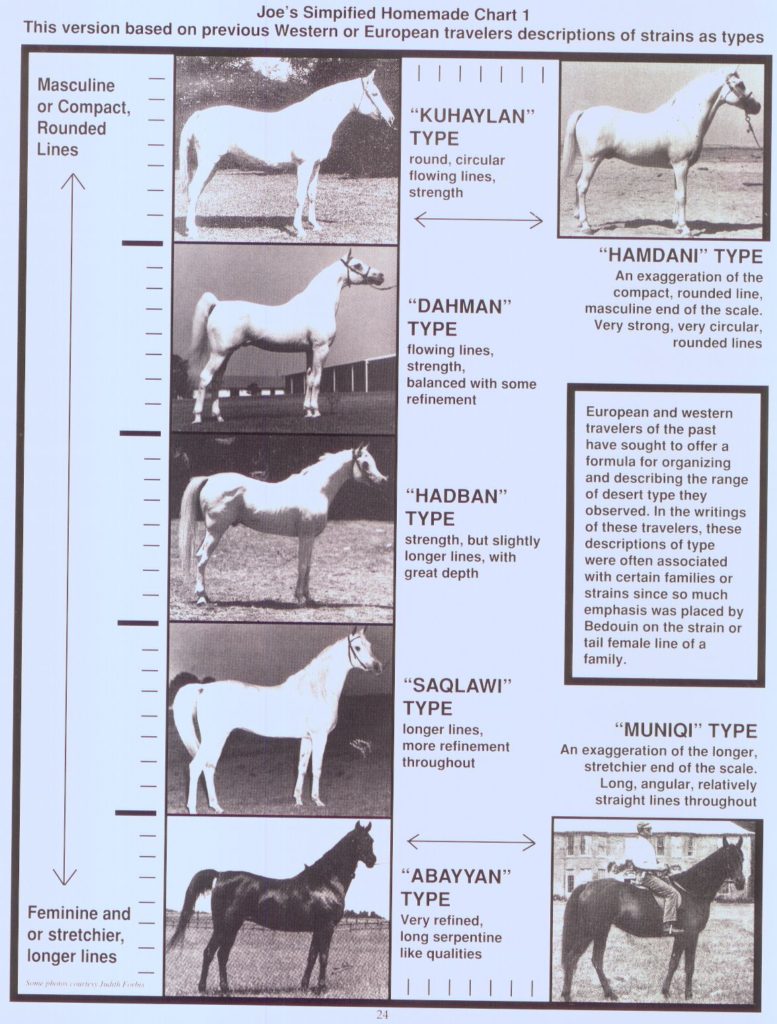
In sim we generally don’t pay much attention to this. (lol) So I will leave that to you to research if you wish.
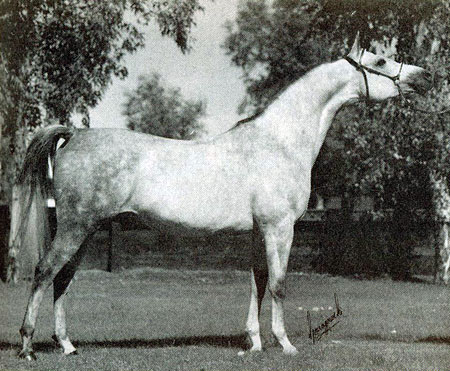
EUKALIPTUS #200635 (*Bandos x Eunice, by Comet) 1974 grey Polish Arabian stallion
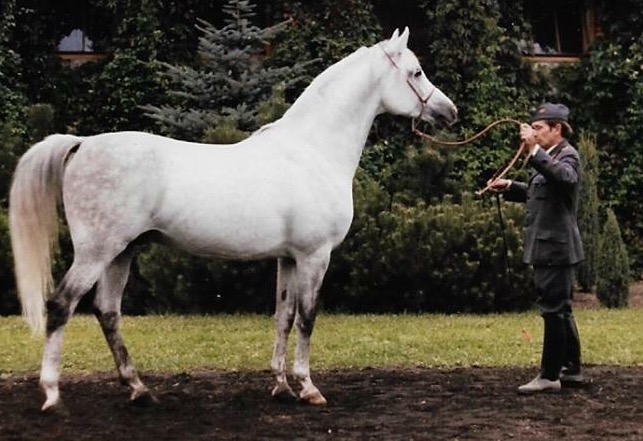
PENTITENT # 407030 (Partner X Penza, by Faher) 1979 grey Polish Arabian stallion
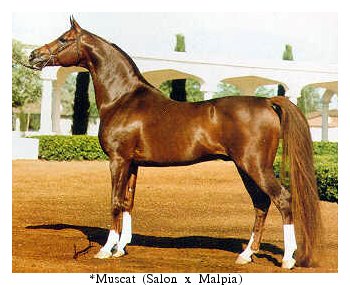
MUSCAT #177179 (Salon x Malpia, by Priboj) 1971 chestnut Russian Arabian stallion
PALAS # 2953 (Aswan x Panel, by Nil) 1968 grey Russian Arabian stallion
Polish and Russian Arabians
Polish or Russian horses are defined as horses whose lines ALL lead to horses that were bred in Poland or Russia.
Poland has Janow Podlaski Stud, Michalow Stud, Bailka Stud, Sieraków
Russia has the Tersk Stud
In the HFAHA a handful of years ago we allowed Russian horses and Russian/Polish crosses to compete in the Polish series as well, which has helped competition.
You will mostly see these horses as sport horses and race horses, though they excel in Europe as halter horses too.
Some Polish horses you may recognize are Eukaliptus, Bandos, Gwarny, Bask, Comet, Grafik, Probat, Palas, Eternit, Sambor, Aladdinn, Negatraz, Witraz, Witez II, Pietuszok, Czort, Strike, Ecaho, Emigrant, and more.
Some Russian horses you may recognize are Knippel, Priboj, Naborr, Aswan, Salon, Muscat, Kubinec, Menes, Penthagonn, Pomeranets, Arax, Nabeg, Topol, Pietuszok, Ptersk, Nartan, Kilimandscharo, and more.
There is no such thing as Polish Related, and you do not call them straight Polish. Fully Polish horses are called “Pure Polish.”
Polish and Russian horses follow a naming rule of the dam’s first letter of her name will also be the first letter of the foal’s name. There are some exceptions to this, such as when the foal took the first letter of the sire’s name but it is rare. If your horse is not Pure Polish or Russian, you may choose to not follow the naming rule in HF. I personally still do for the most part.
For the HF Polish Series, we allow ONLY Pure Polish horses, straight Russian horses, or a combination of Russian and Polish in the bloodlines ONLY. If you are seeing Ali Jamaal, Bey Shah, Fame VF, El Shaklan, Ferzon, Fadjur, etc. in your horse’s line ANYWHERE, they are NOT Polish horses and are not eligible.
If you breed a not-quite-Polish horse (even if one line isn’t Polish) to a Pure Polish horse, the resulting foal WILL NOT be Polish and WILL NOT be eligible for the series.
If you breed a Pure Polish horse with a mostly Polish crossed with Russian horse, the horse WILL be eligible for the series as it will still have only Polish and Russian lines. And vice-versa for mostly Russian horses.
An important note on Russian and Polish bred horses – they are often interchanged among stud farms, so there may be confusion among types. Some examples:
-Gazal Al Shaqab was leased by Poland in 2002-2003, so you see some foals out there that WERE bred by the stud even though Gazal Al Shaqab himself was NOT a Polish horse.
– *Padron was born in Holland, by a sire who is Russian (from Tersk Stud but lines are actually Egyptian, Polish, and French) and imported to Holland, and a dam who is Crabbet and imported to Holland from Belgium. He is technically Russian (though looking at the lines alone you might call him Domestic) yet sometimes we see Polish horses by him here and that would be incorrect. It probably has to do with Padron’s Psyche being exported to Holland and the Polish foals from him.
– Terk Stud imported a large group of Crabbet bred horses as outcrosses, hence finding Crabbet lines in Russian-bred Arabians, as seen with stallions such as Naseem, Negativ, Nabor, Salon, etc. Tersk also absorbed many Polish horses during the evacuation during WWII.
– Aswan was actually a Straight Egyptian horse, but was a cornerstone sire for Tersk Stud and is therefore “Russian.”
– Palas was bred at Tersk and Russian Arabian. However, he was imported to Poland in 1973, and all foals born thereafter at the Polish stud farm are considered Polish. He was also registered in the Polish studbook as PASB#2953.
More on Polish Arabians: www.arabianhorses.org/.content/aha-docs/Bloodline_Arabian_Polish.pdf
More on Russian Arabians: www.arabianhorses.org/.content/aha-docs/Bloodline_Arabian_Russian.pdf
What this means for PASB approved stallions in HF
If you have a stallion who was PASB approved in Chay’s Pride Of Poland event celebration (auction and studbook approvals), or breed to a stallion who is PASB approved, foal resulting from PURE POLISH MARES may be registered a Pure Polish themselves (with the PASB at the end of their name), and are eligible for the series. The stallion himself, while PASB approved, is NOT eligible for the series. If he is bred to mare that is not pure Polish, then the foal’s type would follow the standard of what his type is anyway.
Example: I bred a Domestic mare to Boulad PASB (who is SEA), the foal is Egyptian Related. If I had chosen a pure Polish mare, then Foal CH PASB would be “pure” Polish and could compete in the Polish series.
I do not believe that Chay allows retroactive PASB foals, meaning foals that were born from Polish mares BEFORE his PASB approval will NOT be changed to PASB. But she will need to clarify that for us.
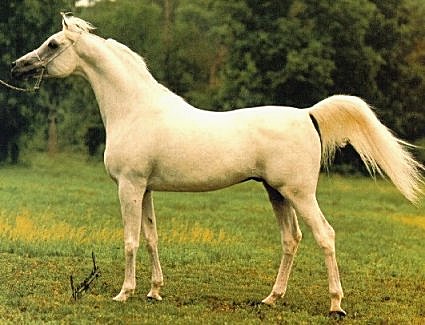
ANSATA HALIM SHAH #219546 (*Ansata Ibn Halima++ x Ansata Rosetta, by Ansata Shah Zaman) 1980 grey Straight Egyptian Arabian stallion
Egyptian Arabians and Relatives
To extrapolate, we have changed the RL rules for Egyptian Related Arabians specifically. Straight Egyptians (SEA) in HF are still defined as horses trace ALL of their lines back to:
– Egyptian bred horses, including those imported to the US
– horses owned or bred by Abbas Pasha I or Ali Pasha Sherif
– used to create and maintain the Royal Agricultural Society (RAS)/Egyptian Agricultural Organization (EAO) breeding programs, with the exclusion of Registan and Sharkasi and their lineal descendants
If your horse fulfills the above, then it may show in the Straight Egyptian Arabian (SEA) section of the Egyptian Halter series from June through November in the AHA.
Most Ansata or Abraxas bred horses are Straight Egyptian. You mostly see these horses in the halter arena, unless of older type in which they excel as endurance horses, hunter pleasure, etc. Some straight Egyptian Arabians you might recognize are ET Crown Prince, The Egyptian Prince, Ansata Halim Shah, Ibn Fa-Serr, Fadl, Orashan, Nabiel, Lancer’s Sahm, Morafic, El Hilal, Ansata Ibn Halima, The Minstril, Simeon Shai, Ruminaja Ali, Ibn Moniet El Nefous, and more.
However, we have changed Egyptian Related (ERA) to simply mean a horse that is 50% or more Egyptian blood (including both sides). If a sire or dam is SEA, then the foal will surely be at least Egyptian Related. The RL definition is more confusing and I will link it here if you are interested in reading it: www.arabdatasource.com/FaqDisplay.asp?id=13
But for HF purposes, it simply must be 50% or more Egyptian blood.
If your horse fulfills the above, then it may show in the Egyptian Related Arabian (ERA) section of the Egyptian Halter series from June through November in the AHA.
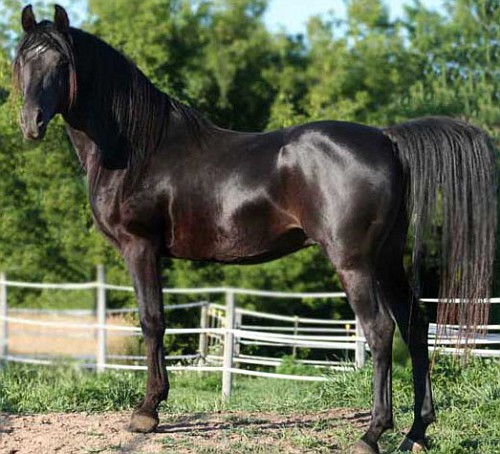
FAA STAR FABAH #558108 (Dahr Fa Halim X Bint Fabadeene, by Fabahdeen) 1998 black Babson Egyptian Arabian stallion
A Babson Arabian is a horse that can trace all of its lines to the six original Straight Egyptian imports by Henry Babson in 1932:
1) *Maaroufa (Ibn Rabdan x Mahroussa)-produced 15 Egyptian foals
2) *Bint Bint Sabbah (Bayyad x Bint Sabbah)-produced 13 Egyptian foals
3) *Bint Serra (Sotamm x Serra)-produced 10 Egyptian foals
4) *Bint Saada (Ibn Samhan x Saada)-produced 3 Egyptian foals
5) *Bint Bint Durra (Ibn Rabdan x Bint Durra)-produced 5 Egyptian foals
STALLION:
1) *Fadl (Ibn Rabdan x Mahroussa)-sired 34 straight Egyptian foals
More on Egyptian Arabians: www.arabianhorses.org/.content/aha-docs/Bloodline_Arabian_Egyptian.pdf
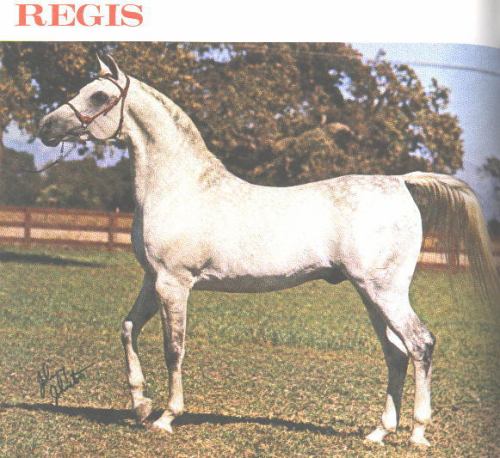
REGIS #16193 (Ferseyn x Farnasa, by *Nasik) 1960 grey Crabbet Arabian stallion
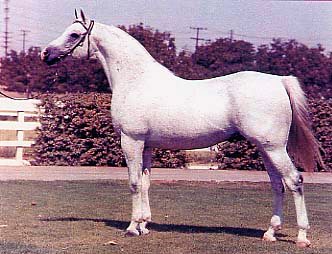
THE REAL MCCOY # 17362 (Aarief X Fersara, by Ferseyn) 1960 Grey Crabbet Arabian stallion
Crabbet and CMK Arabians
All Crabbet Arabians trace their lines back to horses imported and bred by Lady Wentworth and Lady Anne Blunt of Crabbet Stud in England. These horses will trace back to the Egyptian and Bedouin lines, as Lady Anne Blunt was a devout student of the Bedouin breeding standards and methods and imported her horses from these regions. She (and Wilfred Blunt, her ex husband) established the Sheykh Obeyd stud in Egypt. The Egyptian Agricultural Organization lists many Crabbet bred horses as their foundation stock, hence their being many Straight Egyptian lines that are also Crabbet percentage. Also, Skowronek, known as one of the most influential Crabbet sires in history, was actually Polish and imported from Poland.
Spencer Borden, W.R. Brown, Homer Davenport, and W.K. Kellogg, and Bazy Tankersley were the largest importers of Crabbet Arabians in the United States, and many US Crabbet bred horses trace to these breeders.
– Fun fact, W.K. Kellogg is the founder of what we now know as the breakfast cereal (and other products) brand Kellogg.
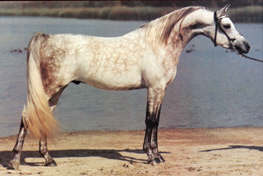
DREAMAZON+++ #154558 (BF Rageymazon X Gai-Ga-Rageyma, by Gai Dream) 1977-96 grey CMK Arabian stallion
CMK Arabians are horses who trace at least 75% their lines to Crabbet of Lady Wentworth in England, Maynesboro of W.R. Brown in New Hampshire, and the W.K. Kellogg program at Pomona in Southern California. It must be noted that ALL CMK horses are Crabbet, but not all Crabbet are CMK. CMK is more of concept built around the preservation of the original type of Arabian imported to the US. You mostly see these horses in Sport Horse In-Hand, sport horse classes, working western classes, endurance, and such.
Examples of horses you may recognize, though each with differing percentages, are *Raffles, Raseyn, Ferzon, Ferseyn, Gai Parada, Dreamazon, *Mirage, Azraff, Skowronek, Rissalix, Indraff, Mesaoud, Serafix, Silvern Magic, Aurab, Naseem, Indian Magic, Abu Farwa, Silver Drift, Gulastra, AA Apollo Bey, Khemosabi, and more. Most Sabino/Dominant White lines originate from the Crabbet and CMK lines.
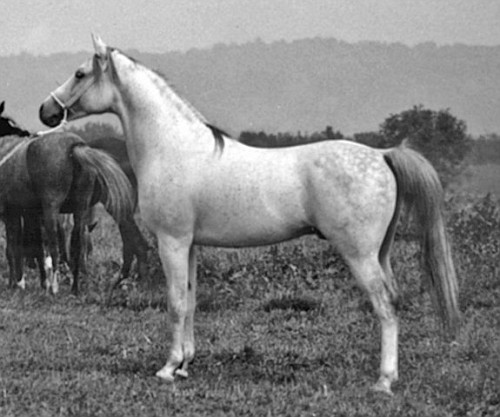
PERICLES #34416 (Tripoli x Dharebah, by Dhareb) 1965 grey Davenport Arabian stallion
Another subset of this are Davenport Arabians, which at least 50% of their bloodlines trace back to the imports of Homer Davenport. There are four female tail lines: Kuhaylan-Haifi, Kuhaylan-Kurush, Hadban, or Schilla. While Davenport horses are often Crabbet based or CMK group, some families were not mixed with Crabbet imports and are actually Egyptian-bred Al Khamsa and Asil qualifying. These horses are characterized by more stocky bodies and straighter profile heads than what you would expect of a “Crabbet” type Arabian.
Crabbet and CMK bred horses qualify for the Crabbet section at the AHA Crabbet Nationals in June.
More on Crabbet Arabians: www.arabianhorses.org/.content/aha-docs/Bloodline_Arabian_Crabbet.pdf
More on CMK Arabians: www.arieana.com/socalcmk/sccmkfaq.html
More on Davenport Arabians: cmkarabians.com/2008/11/21/davenport-arabians/
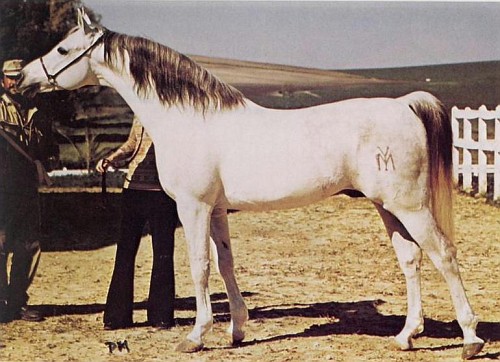
JACIO (Tabal x Teorica, by Barquillo) 1968 grey Spanish Arabian stallion
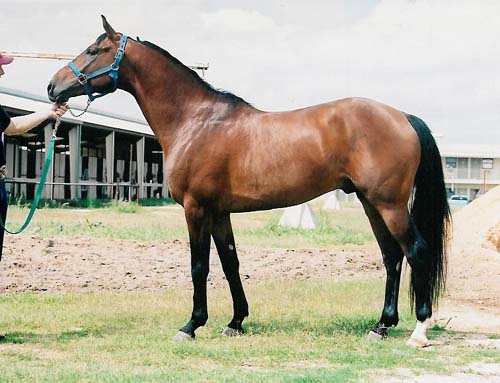
DJET-SET DE FALGAS (Elios de Carrere x Djezabel, by Djelfor) 2001 bay French Arabian stallion
Spanish and French Arabians
Spanish and French Arabians are what their name implies – horses bred in France and Spain.
Historically French horses are more of the athletic type, often bred for racing and not as “pretty” as some of the other types of Arabians. Modern French horses have moved closer to the pretty trend than traditionally, but are still considered sporty athlete type. Recognizable stallions are Bengali D’Albret, Manganate, Baroud II, Maksan, and more.
Spanish horses have had a very closed gene pool since the early 1900’s, though the infusion of Crabbet Arabians is seen. As a result, they are very similar in type to each other with characteristics such as long, streamlined necks and bodies and large eyes. They remain a very small sector of Arabian breeding, though stallions like *AN Malik and *Barich de Washoe became famous in the US. Some top Spanish stallions are Jacio, Tabaco, Garbo, Nabat, Sidi Brahim, and more. Stallions *El Shaklan and Magnum Psyche are half-Spanish.
Read more on Spanish Arabians: www.arabianhorses.org/.content/aha-docs/Bloodline_Arabian_Spanish.pdf

KHEMOSABI++++// (Amerigo X Jurneeka++ by Fadjur) 1967 bay Domestic Arabian stallion
Domestic Arabians
Domestic Arabians are essentially considered a melting pot of bloodlines, especially for sim purposes. Historically, they are largely based on Crabbet and CMK, though infused lines of Egyptian, Polish, French, etc. are seen as well, though historical stallions such as *Fadl, Gulastra, *Raseyn, *Mirage, Azraff, *Nasr, *Czubuthan, Witraz, Wielki Szlem, Gazi, Hallany Mistanny, and more.
More current horses you may recognize at a glance that are considered domestic are Fadjur, Bey Shah, Huckleberry Bey, Barbary, Khemosabi, Magnum Psyche, Baskafire, Fame VF, Kontiki, Showkayce, Sam Tiki, Marwan Al Shaqab, Juyllen El Jamaal, and more. These are horses that will be mostly found as halter, saddleseat, western types.
Especially for sim purposes, if you find your horse doesn’t clearly fit into any of the “pure type” categories above in ALL family lines, you will simply call it a Domestic Arabian.
Domestic bred horses qualify for the Domestic section at the AHA Crabbet Nationals in June. Horses who qualify for the Polish series or the Egyptian series DO NOT QUALIFY for the Crabbet Nationals, even if the horse is Egyptian Related.
More on Domestic Arabians: www.arabianhorses.org/.content/aha-docs/Bloodline_Arabian_Domestic.pdf
This gives us something to observe when we get ready to enter the upcoming Polish and Egyptian Series shows. Please take a closer look at your lines to be sure you aren’t entering a non-qualified horse, which isn’t quite fair to those who are. Some members over the years have purchase a horse registered as a certain type, and upon further inspection of their lines they actually were not, and this changed their whole breeding program. Don’t let this happen to you.

Now, if you have any questions, and I mean ANY (specific horses, clarification, etc.) please post them here so we can all learn together! Chelsea and I are happy to help you out so that you can enjoy your beautiful Arabians and have them showing appropriately.
